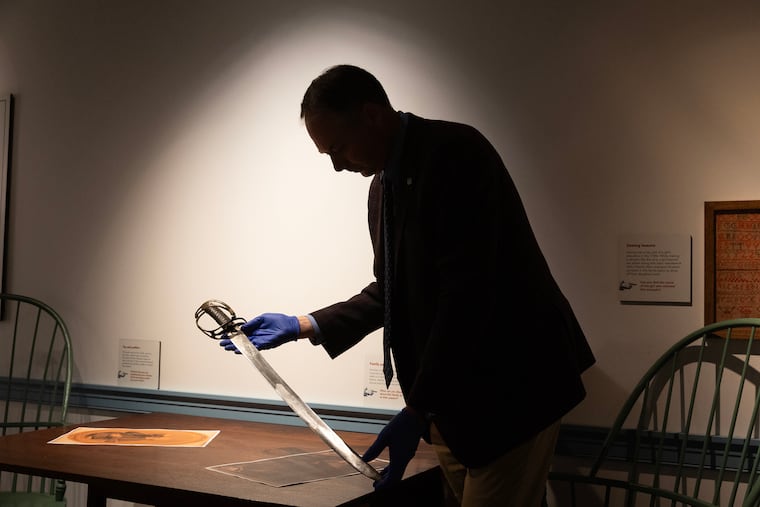A rare sword gifted by the Marquis de Lafayette will be publicly displayed for the first time in a century
The Marquis de Lafayette gifted the sword to a soldier who survived Valley Forge and later fought under Alexander Hamilton.

When Jeremiah Keeler made his way through Philadelphia as a battle-weary member of the victorious Continental Army in 1781, he used a very famous sword as a crutch, according to family lore.
Just the year before, Keeler, a 21-year-old sergeant in the Army Corps of Light Infantry, had been presented with an engraved, French-made battle sword by no less than the Marquis de Lafayette. Keeler unsheathed his shiny new blade at the decisive battle of Yorktown during a charge led by Alexander Hamilton — a daring nighttime raid that helped bring about the British surrender and would, over two centuries later, be immortalized by Lin-Manuel Miranda on Broadway.
Slowly making his way home to his native Connecticut, Keeler used his cherished cutlass as an unyielding clutch, the legend goes. One of only a few surviving swords gifted to Continental soldiers by America’s favorite fightin’ Frenchman, Keeler’s blade has now returned to Philly. And for good.
Donated to the Museum of the American Revolution by Keeler’s direct descendant earlier this year, the historic sword will be on display as part of the museum’s core exhibit starting Nov. 5.
“These swords are incredibly rare,” said Scott Stephenson, the president and CEO of the museum. “There are probably less than a half-dozen that survived, and what makes this one really unique is that there are only two where we know who actually carried it.”
Along with the 38-inch iron and steel blade, and its worn leather scabbard, the museum will also display a 19th-century daguerreotype of an aged Keeler posing with his sword. It is one of the only known photographs of a Revolutionary War veteran with an object they carried in battle, Stephenson said.
The weapon represents the second major addition to the museum this year. In July, the museum debuted a previously unknown scrap of its crown jewel, George Washington’s war tent, that a Virginia man had found at Goodwill.
A bridge to history
With its intimate connections to both Lafayette and Hamilton, and to pivotal moments of the war, the sword serves as a visceral bridge to history, Stephenson said.
“It’s important to be in the presence of these real things,” he said. “These are the real witnesses to that experience.”
Keeler had more than earned his deadly gift from Lafayette. As a young soldier, still in his teens, he had survived the desperate winter at Valley Forge and the pitched battle of Monmouth (a costly draw, if you remember the musical Hamilton).
When Lafayette returned to the war after a trip home to France in 1779, he brought with him 400 swords for the leaders of his brigade. Each bore an image of a flaming bomb engraved near the brass handle — a symbol commonly used by the French army, said James Taub, an associate curator at the museum — and the letters “U.S.A.” etched in elegant script.
“Lafayette presented one to each of these noncommissioned officers, reportedly with his own hand,” Stephenson said.
Almost all of the other Lafayette-gifted swords disappeared over the centuries, lost to time and memory. The Keeler family cherished Jeremiah’s sword.
Keeler’s great-great-great-great-granddaughter, Suzanne Reynolds, who is 73 and lives in Michigan, said she decided to donate the sword after her mother, Helene, died on Christmas Day. For decades, Helene Keeler — whose French mother had met her soldier father in Paris during WWI — had proudly kept the sword perched above the family fireplace.
“The sword was a symbol in our family of not Jeremiah Keeler and his family, but of the great contribution the French made,” Reynolds said. “The museum is the right place for the sword to be and for the rest of the country and the world to see it and appreciate it.”